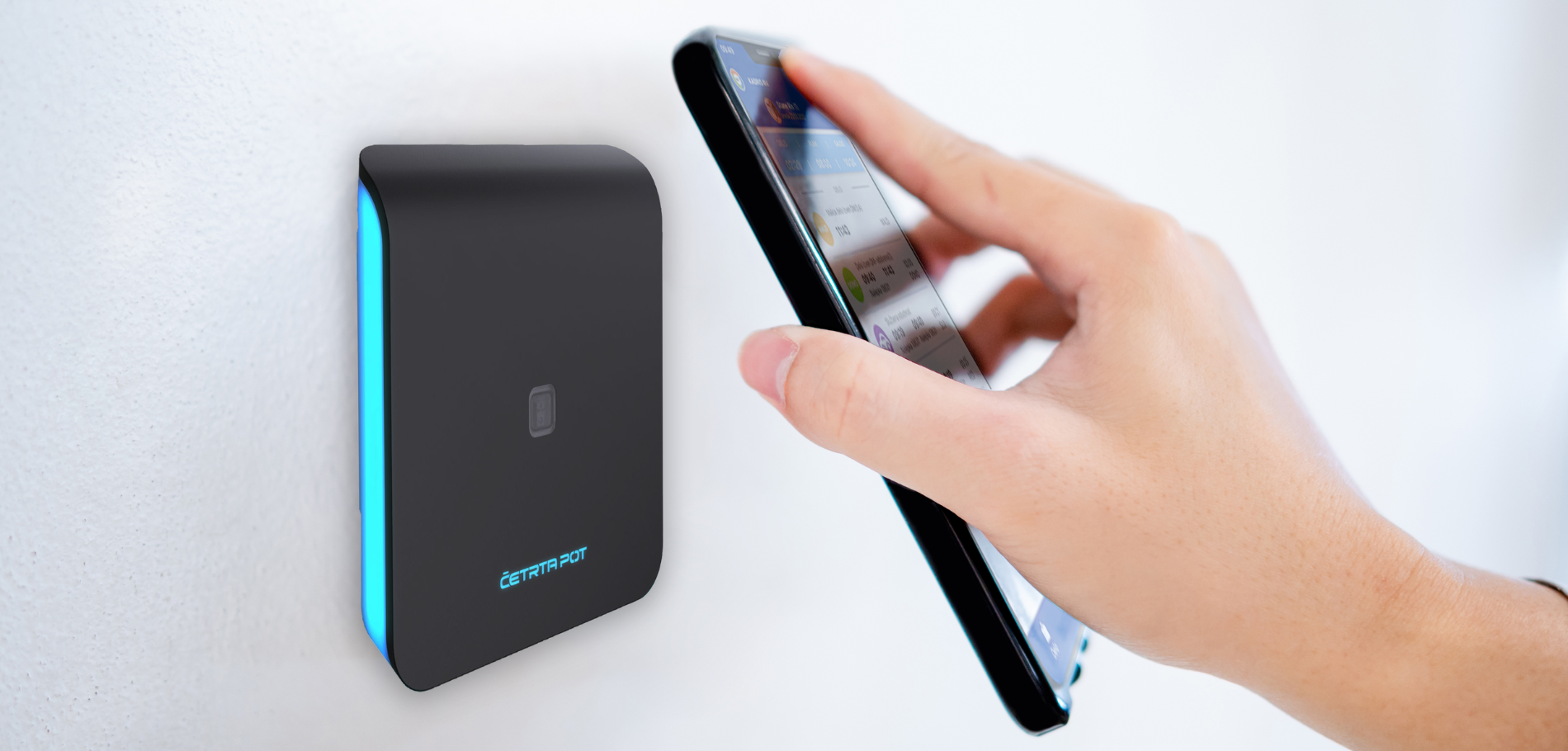Izvedba varnega sistema kontrole dostopa je resen projekt, ki ga kaže zaupati strokovnjakom. Kartice, sploh starejše, namreč lahko nepridipravi tudi ponaredijo, in to z orodji, ki jih za vsega nekaj deset evrov kupijo na spletu. »Sistemov kontrole dostopa ni priporočljivo nabavljati parcialno in od priložnostnih uvoznikov posameznih komponent z Daljnega vzhoda. Že res, da tam posamezno kartico lahko kupite za en evro, a isti tip kartice, ki je hkrati tudi primerno zaščiten, vas lahko stane nekajkrat več denarja. Groba analogija je prazen zapisljiv medij v primerjavi z zgoščenko z licenčno glasbo ali programsko opremo,« je pojasnil Tomaž Frelih, direktor področja Sistemi v podjetju ČETRTA POT.
Odpiranje vrat prek mobilne aplikacije in sistema v oblaku
Bi vrata odpirali z mobilnikom? Ta funkcionalnost je morebiti res redkeje uporabna v poslovnem svetu, je pa toliko bolj zanimiva v potrošniškem segmentu. Sploh, ker za vpeljavo ne zahteva bralnikov kartic ali čipov NFC na vratih, vsa komunikacija pa poteka prek interneta.
Mobilni telefon sproži zahtevo v oblaku, ta pa sporoči ukaz pametni ključavnici, ki je prav tako kot cel pametni dom povezana v internet. Tako lahko uporabnik odpre vrata tudi na daljavo (sorodniku, dostavljavcu paketov, poštarju ipd.), čeprav je na drugem koncu planeta. To se sicer lepo sliši, a je uporabno predvsem za področja, kjer je varnost manj pomembna oziroma jo zaupamo ponudniku sistema. Praksa namreč pozna že več varnostnih incidentov, saj so tako uveljavljeni proizvajalci kot tudi razna zagonska podjetja poudarjali predvsem veliko enostavnost, na varnost pa »pozabili«. Zato so se dogajala odpiranja stanovanj gostom sistema Airbnb, ključavnic avtomobilov ponudnikov storitev deljenih prevozov, vrat dostavljavcem paketov (Amazon ipd.). A tudi kartične rešitve niso nič boljše, nasprotno, lahko so celo slabše, saj je njihova posodobitev zahtevnejša. Primitivna varnostna rešitev hotelskih sistemov švedskega proizvajalca je lani razkrila velikansko težavo, ki obstaja na okoli milijon vratih hotelskih sob v približno 40 tisoč hotelih po svetu. »V ČETRTI POTI jemljemo varnost zelo resno in brezkompromisno, in to prav na vseh komponentah naših sistemov. Uporabljamo ta hip v svetu najvarnejše kartične tehnologije, vse naprave in komunikacije smo zaščitili s kriptografskimi algoritmi. Še posebej smo se varnosti resno lotili pri uvedbi mobilne identifikacije na mobilnih platformah Android in iOS, kjer smo vpeljali v bančnem svetu preverjeno tehnologijo tokenizacije in varno generiranje žetonov, hkrati pa omogočili enostavnost uporabe. Poleg certificiranih produktov je podjetje certificirano po varnostnih standardih za informacijsko varnost ISO-27001 in ISO-27018,« je ukrepe za zagotavljanje varnosti rešitev za identifikacijo in kontrolo dostopa razložil Frelih.
Uvajanje mobilne identifikacije
Študije kažejo, da se ljudje le redko ločimo od svojih mobilnikov. Še več, 70 odstotkov ljudi ima pametni telefon 24 ur na dan pri roki. In ker so te naprave, ki so včasih stavile na govorno komunikacijo, računalniki v malem, obvladajo »pretvarjanje «, da so še kaj drugega – na primer fotoaparati, pospeškomeri, denarnice oziroma plačilne kartice, so seveda lahko tudi identifikacijske rešitve. Danes je že tako, da obstaja večja verjetnost, da imamo s seboj pametni telefon kot identifikacijske kartice ali obeske. Toda raba mobilne identifikacije je sprožila vrsto varnostnih vprašanj. V nasprotju s karticami, ki so varnostno certificirane, pametni telefon privzeto ni varen oziroma je bolj dovzeten za zlorabe. Ima pa drugo prednost, ki je kartica nima – spletni dostop in možnost nalaganja aplikacij. »Shraniti varnostne ključe na telefon bi bilo samomorilsko, « je bil slikovit Frelih. »Zato se je uveljavila tehnologija žetonov, ki omogoča, da varovan kriptostrežnik za vsak posamezen telefon ustvari kriptirano kodo z omejeno veljavnostjo – na primer en dan.« Ta žeton se nato hrani v telefonu, in ko bralnik vzpostavi komunikacijo s telefonom, bralnik žeton sprejme od telefona, ga dekodira s svojimi ključi ter ugotovi identiteto uporabnika in veljavnost žetona. Tak varnostni mehanizem seveda ni stoodstotno varen, je pa vsekakor dovolj zanesljiv, zato se je uveljavil pri mobilnem plačevanju (Google Pay, Apple Pay, Samsung Pay ipd.).
Članek je bil objavljen 20. junija 20. junija 2019 v poslovnem časopisu Finance in 21. junija na spletnem portalu Finance IKT oz. TUKAJ.



